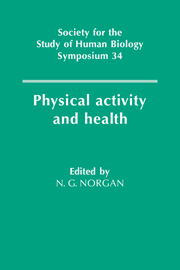Book contents
- Frontmatter
- Contents
- List of contributors
- Acknowledgements
- 1 Introduction
- 2 Comparative aspects of human activity
- 3 Physical activity levels – past and present
- 4 The validity of health measurements
- 5 Developments in the assessment of physical activity
- 6 Two national surveys of activity, fitness and health: the Allied Dunbar National Fitness survey and the Welsh Heart Health survey
- 7 Physical development and childhood activity
- 8 Physical activity and behavioural development during childhood and youth
- 9 Physiological aspects of activity and ageing
- 10 Activity and morale in later life: preliminary analysis from the Nottingham Longitudinal Study of Activity and Ageing
- 11 The benefits of low intensity exercise
- 12 Physical activity, obesity and weight maintenance
- 13 Adherence to physical activity and exercise
- 14 Women's working behaviour and maternal-child health in rural Nepal
- 15 Physical activity and psychological well-being
- 16 Leisure lifestyles: present and future
- Index
5 - Developments in the assessment of physical activity
Published online by Cambridge University Press: 05 December 2011
- Frontmatter
- Contents
- List of contributors
- Acknowledgements
- 1 Introduction
- 2 Comparative aspects of human activity
- 3 Physical activity levels – past and present
- 4 The validity of health measurements
- 5 Developments in the assessment of physical activity
- 6 Two national surveys of activity, fitness and health: the Allied Dunbar National Fitness survey and the Welsh Heart Health survey
- 7 Physical development and childhood activity
- 8 Physical activity and behavioural development during childhood and youth
- 9 Physiological aspects of activity and ageing
- 10 Activity and morale in later life: preliminary analysis from the Nottingham Longitudinal Study of Activity and Ageing
- 11 The benefits of low intensity exercise
- 12 Physical activity, obesity and weight maintenance
- 13 Adherence to physical activity and exercise
- 14 Women's working behaviour and maternal-child health in rural Nepal
- 15 Physical activity and psychological well-being
- 16 Leisure lifestyles: present and future
- Index
Summary
Introduction
Numerous methods have been used to assess levels of physical activity in both individuals and populations. All such techniques have advantages and disadvantages and none is entirely satisfactory. The importance of being able to monitor and measure activity levels can be shown easily (Malina, Panter-Brick, 1992; Hardman, this volume), and therefore new methods for measuring physical activity precisely and accurately are being considered constantly. Long-standing methods for the assessment of activity levels include those using mechanical devices, such as actometers, accelerometers and pedometers, heart rate monitoring, video recording and diary records. Some of these techniques do not necessarily measure all types of activity, i.e. pedometers and actometers, whilst others are not applicable to large groups of individuals, e.g. video recording, and others can be very time-consuming, e.g. diary records.
Physical activity is one component of total energy expenditure (TEE). By far the largest contribution to total energy expenditure is basal metabolic rate (BMR). The difference between BMR and TEE is the energy cost of thermoregulation, dietary induced thermogenesis, the energy cost of growth and energy expended in physical activity. The first two of these components are really quite small and, after the first 2 years of life, the energy cost of growth has diminished to a negligible amount. Thus the difference between TEE and BMR in children, adolescents and adults is primarily due to the energy expended in physical activity.
- Type
- Chapter
- Information
- Physical Activity and Health , pp. 45 - 56Publisher: Cambridge University PressPrint publication year: 1992
- 2
- Cited by

